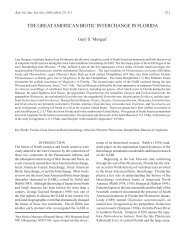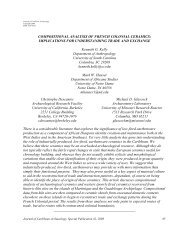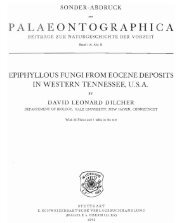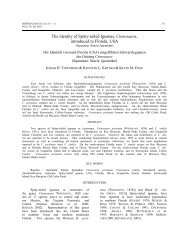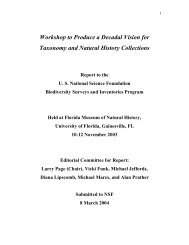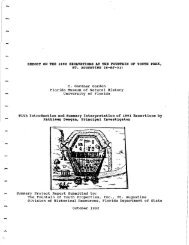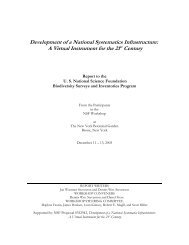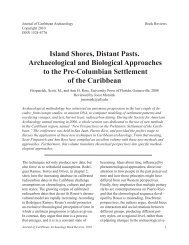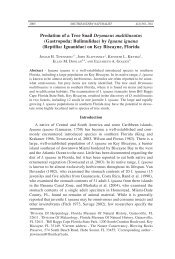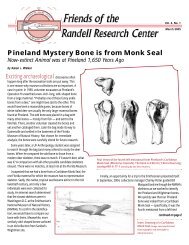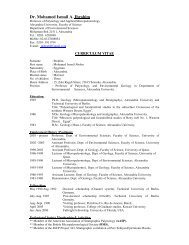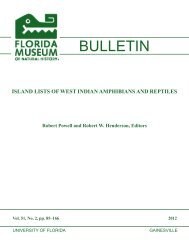Early angiosperms from the Lower Cretaceous of Jixi, eastern ...
Early angiosperms from the Lower Cretaceous of Jixi, eastern ...
Early angiosperms from the Lower Cretaceous of Jixi, eastern ...
Create successful ePaper yourself
Turn your PDF publications into a flip-book with our unique Google optimized e-Paper software.
G. Sun, D.L. Dilcher / Review <strong>of</strong> Palaeobotany and Palynology 121 (2002) 91^112 99<br />
Genus <strong>Jixi</strong>a Guo et Sun, 1992<br />
Type: <strong>Jixi</strong>a pinnatipartita Guo et Sun emend.Sun<br />
et Dilcher<br />
Generic diagnosis: Leaf simple, pinnately lobed,<br />
lobes opposite to alternate.Obtuse sinuses extending<br />
to near midvein.Venation pinnate.Midvein<br />
prominent, arched to zigzag.Secondary veins decurrent<br />
along midvein, transversing lamina lobe<br />
near admedial margin.Tertiary and quaternary<br />
veins present.Marginal vein present.<br />
<strong>Jixi</strong>a pinnatipartita Guo et Sun emend. Sun et<br />
Dilcher<br />
Plate II, 1,9;Fig.4D<br />
Synonyms:<br />
1992a <strong>Jixi</strong>a pinnatipartita Guo et Sun; Sun et al., p. 547, pl.<br />
I, ¢gs.10, 12; (non pl.I, ¢g.11).<br />
1992a Rogersia lanceolata Fontaine; Sun et al., p. 543, pl. I,<br />
¢g.15.<br />
1995 <strong>Jixi</strong>a pinnatipartita Guo et Sun; Sun, p.429, pl.141,<br />
¢g.4; text-¢g.9^2, 3.<br />
1996 <strong>Jixi</strong>a pinnatipartita Guo et Sun; Sun and Dilcher, p.<br />
393, pl.1, ¢g.10; text-¢g.1C.<br />
Emended description: Leaf simple, deeply once<br />
pinnately lobed, ca. 1.5^4.5 cm long by 0.6^4.0<br />
cm wide.Margin entire.Apex not preserved;<br />
base narrow cuneate.Petiole incomplete.Lobes<br />
subopposite to alternate, vary in number, form<br />
and size.Basal lobes shorter and appear placed<br />
at an angle <strong>of</strong> 80‡ to <strong>the</strong> midvein.Median lobes<br />
narrowly oblong orientated at angles <strong>of</strong> 60^70‡ to<br />
<strong>the</strong> midvein, extending free some distance <strong>from</strong><br />
<strong>the</strong> central leaf lamina.Deep obtuse sinuses with<br />
rounded margins extending nearly to <strong>the</strong> leaf midvein<br />
separate <strong>the</strong> lobes.Midvein arched, prominent<br />
and giving rise to prominent secondary veins<br />
that arch gradually paralleling <strong>the</strong> midvein for a<br />
short distance, a signi¢cant portion <strong>of</strong> <strong>the</strong> midvein<br />
appears to feed into each secondary vein.The secondary<br />
veins innervate <strong>the</strong> lobes asymmetrically<br />
transversing <strong>the</strong> lamina lobe nearer <strong>the</strong> admedial<br />
lobe margin.Tertiary veins branch at an angle <strong>of</strong><br />
75‡ and are <strong>of</strong>ten parallel, may branch once near<br />
<strong>the</strong> leaf margin before joining a marginal vein.<br />
Some tertiary veins extending into narrow lamina<br />
<strong>of</strong> <strong>the</strong> lobes depart at an angle <strong>of</strong> nearly 90‡.<br />
Quaternary venation may branch at nearly right<br />
angles <strong>from</strong> <strong>the</strong> tertiary veins forming poorly preserved<br />
areoles.<br />
Discussion: The emended description <strong>of</strong> <strong>the</strong><br />
present species is mainly supplemented by having<br />
<strong>the</strong> evident marginal vein and <strong>the</strong> character classi-<br />
¢ed <strong>of</strong> its tertiary and quaternary venation.One<br />
<strong>of</strong> <strong>the</strong> specimens originally described as <strong>the</strong><br />
present species (Sun et al., 1992a, p.547, pl.I,<br />
¢g.11) di¡ers <strong>from</strong> <strong>the</strong> present species in having<br />
a multi-lobed leaf, and secondary veins arising<br />
opposite or nearly opposite <strong>from</strong> <strong>the</strong> midvein.<br />
Therefore, this species <strong>of</strong> <strong>the</strong> genus Rogersia originally<br />
described by Fontaine (1889), has been assigned<br />
to a new species described below in detail.<br />
Reviewing <strong>the</strong> specimen Rogersia lanceolata, originally<br />
described by Sun et al.(1992a, p.543, pl.I,<br />
¢g.15) is actually a segment lobe <strong>of</strong> <strong>the</strong> present<br />
species.<br />
Material: 6 specimens.<br />
Locality and horizon: Ibid., in <strong>the</strong> W-B section<br />
beds Nos.45 and 47.<br />
<strong>Jixi</strong>a chengzihensis Sun et Dilcher sp. nov.<br />
Plate II, 2, 3, 5^8, 10, 11, 13; Fig.4F,I<br />
Synonyms:<br />
1992a <strong>Jixi</strong>a pinnatipartita Guo et Sun; Sun et al., p. 547, pl.<br />
I, ¢g.11.<br />
1995 <strong>Jixi</strong>a chengzihensis Sun et Dilcher; Sun, p.429, p1.<br />
141, ¢gs.5, 7, text-¢g.9^2, 4; [nomen nudum, nomen<br />
invalidum].<br />
1996 <strong>Jixi</strong>a chengzihensis Sun et Dilcher; Sun and Dilcher,<br />
p.393, p1.1, ¢g.11, text-¢g.1D; [nomen invalidum].<br />
Description: Leaf simple, deeply pinnately lobed.<br />
Lobes may have pinnate shallow lobes, usually<br />
1.7^3.2 cm long by ca. 2.0 cm wide. Margin entire.Apex<br />
and base not preserved.Primary lobes<br />
opposite to subopposite, vary in size and shape.<br />
Some lobes preserved are ca. 1.0 cm long by 0.3^<br />
0.4 cm wide at lobe base increasing to 0.7^0.8 cm<br />
wide where secondary lobes are present.One or<br />
two pairs <strong>of</strong> secondary lobes borne <strong>from</strong> middle<br />
to apex <strong>of</strong> <strong>the</strong> primary lobe.Secondary lobes subopposite<br />
with rounded apex.Midvein <strong>of</strong> leaf progresses<br />
somewhat zigzag fashion <strong>from</strong> lobe to<br />
lobe.Midvein prominent, 0.6 mm wide basally<br />
and tapers distally.Secondary veins slightly irregular<br />
that extend into <strong>the</strong> secondary lobes.Tertiary



